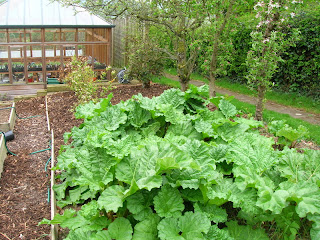The hungry gap is over, thanks to the welcome return of the rhubarb. The tightly wrapped leaves slowly unfurl in March and by the middle of April visitors are invited (bribed) to take some away. We have a patch which is too large for our needs but it does brighten up the garden with its big, bold leaves. The fresh greenery on the veg plot makes me feel that there is energy and abundance in the air.
Rhubarb is probably the weirdest of all the crops we grow but it is not everyone’s favourite. Interestingly, from a botanical point of view it is actually a vegetable and related to the herb, sorrel. Its sharp, unique flavour sends those with a sweet tooth rushing for the bag of sugar and its medicinal qualities to put it politely, have a tendency to make you want to ‘go’. In fact for most of its 5,000 year history, dried rhubarb roots have been used for their laxative qualities rather than as a food.
Rhubarb leaves are poisonous which also puts some people off growing it. However at Springfield we like to live dangerously and although rhubarb contains high levels of oxalic acid (an organic poison and corrosive) it takes 5 kilos of leaves to kill a person. There are many toxic plants in a garden, we just tread carefully and train small children not to touch plants without a grown up about. No-one has ever accidentally (or purposefully) eaten a rhubarb leaf in our garden.
Rhubarb did not appear in recipes until the 19th century. In 1824 Joseph Myatt, a South London nurseryman had some rhubarb plants and produced a recipe for some tarts. He persuaded others that the bitter plant tasted good when combined with something sweet. The timing was perfect because sugar was just becoming available and affordable and the rhubarb stalks were otherwise going to waste. The other advantage was that the rhubarb was ready for harvest well before most other vegetables and with forcing it could be made available even earlier.
Rhubarb’s fame peaked before the second World War and large commercial quantities of it were grown outdoors as well as in greenhouses. Use dropped dramatically during the war sugar was rationed and rhubarb production has never returned to the previous levels of production but it is still flourishing. The Wakefield-Leeds-Morley rhubarb-growing triangle in West Yorkshire has been the centre for forced rhubarb for 150 years and there is an annual Festival every year to mark its importance. It is unknown why it was grown in the Wakefield area but the forcing sheds, although lesser in number, are part of the local landscape. Apparently, the rhubarb sheds are a spooky place by candlelight and, if you are very quiet, you can actually hear the plants growing…
There are over 60 varieties of rhubarb which is surprising. The RHS recommends: Timperley Early (AGM) and Hawkes Champagne (AGM). Victoria is a later type. We inherited our patch so our rhubarb is Variety Unknown. We just divide the crowns now and then and grow on new plants. It tastes good which is the main thing.
Being a perennial outside the crop rotation, rhubarb is very easy to grow. It does not suffer from any pests and will tolerate a bit of shade. It is very rich in vitamin C which means it is good for us, despite the oxalic acid! In early spring we spread lots of compost on the area and try to keep the area as weed free as possible. We usually stop harvesting the stalks before June to let the plants recover. If there is little rainfall the crop does suffer so we may stop picking earlier if the weather is particularly dry. We find that removing the flower heads helps to strengthen the plants and along with the leaves, they all go on the compost heap.
In March, we force one of the crowns under an old terracotta pot and this produces tender pink stalks which are lovely when lightly baked with the rind and juice of an orange. It really does perk up the muesli and yogurt. We force a different crown each year, otherwise it weakens the plant, but I do forget which one needs a turn.
Yesterday I made a delicious rhubarb cake. I lined an 8-9 inch (21-23 cm) deep sided cake tin with baking parchment. I creamed 100 g each of caster sugar and soft margarine and then beat in 2 eggs. Then I folded in 125g SR flour, sieved with 1 tsp baking powder and half a tsp dried ginger. I stirred in the juice from half an orange and spooned the mixture into the tin. I topped the cake mixture with approximately 450 g chopped rhubarb tossed in a grated orange rind, a little demara sugar and 2 diced balls of stem ginger from a jar. To finish, I sprinkled over two large scoops of crumble mix from the freezer and baked the cake at gas mark 4, 180 C for about an hour. Ginger and rhubarb are a marriage made in heaven!
Our plot simply would not be complete without rhubarb. I have a real nostalgia for it. Years ago, shortly after Mum died, a neighbourly widow (in full make-up and new hairdo) presented my Dad with a homemade apple pie. Dad disliked apple pie and commented rather smugly to me that She would have to work harder than that to gain his affections. The following week, She presented him with a rhubarb crumble and he his expression had changed to fear. He was desperate for the crumble – his favourite – and equally desperate to remain single. So a bargain was struck. From then on, I made the Rhubarb crumbles and She received nothing more than a quick 'hello' over the garden gate....

No comments:
Post a Comment